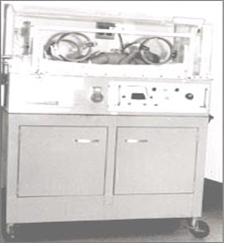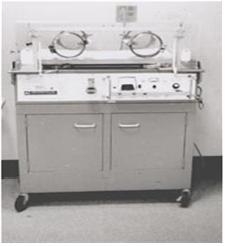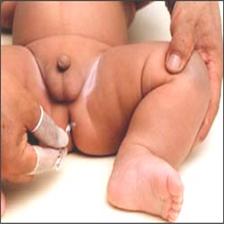신생아 정상 체온과 미숙 신생아의 체온조절, Normal temperature of newborn infants and body temperature regulation in premature infants

사진 2. 신생아들은 스스로 체온을 원숙하게 조절하지 못한다. 특히 미숙 신생아로 태어난 신생아들은 스스로 체온조절을 하는데 어려움이 많다.
신생아실에서는 신생아의 체온을 적절히 유지하기 위해서 신생아들에게 모자를 씌우고 옷을 적절히 잘 입힌다. 그리고 포대기나 담요 등으로 적절히 잘 싸서 체온이 낮아지지 않게 보호해준다.
때로는 어떤 이유로 체온 조절을 잘 할 수 없는 미숙 신생아들이나 신생아들은 자신이 스스로 체온 조절을 적절히 할 수 있을 때 까지 보육기 속에서 키우다가 그 다음은 클립으로 옮겨 거기서 양육하고 거기서도 스스로 체온을 잘 조절할 수 있고 체중이 계속적으로 증가되고 건강하면 집으로 퇴원시키는 식으로 육아한다.
Copyright ⓒ 2011 John Sangwon Lee, MD., FAAP

사진 3. 앓는 만삭에 태어난 정상 신생아들, 병을 앓는 만삭 신생아들이나 체중아, 작은 미숙 신생아들은 신생아기 이후 건강한 영아들처럼 체온 조절을 스스로 잘 하지 못하는 것이 보통이다. 그들이 스스로 체온을 잘 조절 할 수 있을 때까지 필요에 따라 인큐베이터(보육기) 내에서 양육할 때가 많다.
Copyright ⓒ 2011 John Sangwon Lee, MD., FAAP

사진 4. 만삭 신생아들, 특히 어떤 병을 앓는 신생아들, 아주 작은 미숙신생아들은 신생아기 이후 건강한 영유아들처럼 체온 조절을 스스로 잘 못하는 것이 보통이다. 이런 이유로 체온 조절을 스스로 잘 할 수 있을 때까지 미숙 신생아를 인큐베이터(보육기) 내서 양육하는 것이 보통이다.
Copyright ⓒ 2011 John Sangwon Lee, MD., FAAP

사진 5. 항문 체온을 잰다.
Copyright ⓒ 2011 John Sangwon Lee, MD., FAAP
- 미숙 신생아의 체온 조절 중추 기능은 만삭에 태어난 건강한 신생아의 체온 조절 중추 기능에 비해 덜 발육되어 있고 미숙하게 기능한다.
- 미숙 신생아의 총 체 표면적의 크기는 자신의 체중에 비하여 훨씬 더 넓고 피하 지방 조직층은 아주 얇다.
- 이런저런 이유로 미숙 신생아들은, 특히 아주 작은 저 체중 미숙 신생아들은 상당히 크게 성장할 때까지 스스로 체온 조절을 잘 못하는 것이 보통이다.
- 주위 온도가 갑작이 높아지면 미숙아의 체온도 주위 온도에 따라 덩달아 올라가고, 반대로 주위 온도가 갑작이 내려가면 체온도 주위 온도에 따라 덩달아 내려갈 수 있다.
- 이런저런 이유로, 출생 시 체중이 2.5kg 이하 되는 미숙 신생아들이나 저체중 신생아들이 자기 스스로 체온을 조절할 수 있을 때까지 그들을 보육기 속에서 양육하는 것이 일반적이다. 신생아의 체온,신생아 탈수 열 참조
Normal temperature of newborn infants and body temperature regulation in premature infants 신생아 정상 체온과 미숙 신생아의 체온조절

Picture 2. Newborns cannot control their own body temperature well. In particular, newborns born as immature newborns have a lot of difficulty in controlling their own body temperature. In the neonatal room, to keep the newborn’s body warm properly, hats are put on the newborns and clothes are properly dressed.
And it protects the body temperature from lowering by wrapping it properly in a bag or blanket.
Sometimes, for some reason, immature newborns or newborns who are unable to control their body temperature well are raised in the incubator until they are able to properly control their body temperature, then moved to a clip and raised there, where they can control their body temperature well.
If this continues to increase and is healthy, raise it by discharging it home. Copyright ⓒ 2011 John Sangwon Lee, MD., FAAP

Photo 3. Normal newborns born in the afflicted term, sick term newborns, overweight, and small immature newborns are usually unable to control their body temperature as well as healthy infants after the newborn period. They are often reared in incubators as needed until they are able to control their body temperature well. Copyright ⓒ 2011 John Sangwon Lee, MD., FAAP

Photo 4. Full-term newborns, especially those with certain diseases, and very small premature newborns are usually unable to control their body temperature as well as healthy infants after the neonatal period. For this reason, it is common to raise an immature newborn baby in an incubator until it is able to control its body temperature well on its own. Copyright ⓒ 2011 John Sangwon Lee, MD., FAAP

Picture 5. Take the temperature of the anus. Copyright ⓒ 2011 John Sangwon Lee, MD., FAAP
- The central function of body temperature control in immature newborns is less developed and functions immaturely than that of healthy newborns born at term.
- The total body surface area of immature newborns is much wider than their own weight, and the subcutaneous adipose tissue layer is very thin.
- For one reason or another, it is common for immature newborns, especially very small, low-weight immature babies, to control their own body temperature well until they grow considerably larger.
- When the ambient temperature suddenly rises, the body temperature of a premature infant rises according to the ambient temperature, and the opposite
출처 및 참조 문헌 Sources and references
- NelsonTextbook of Pediatrics 22ND Ed
- The Harriet Lane Handbook 22ND Ed
- Growth and development of the children
- Red Book 32nd Ed 2021-2024
- Neonatal Resuscitation, American Academy Pediatrics
- www.drleepediatrics.com 제1권 소아청소년 응급 의료
- www.drleepediatrics.com 제2권 소아청소년 예방
- www.drleepediatrics.com 제3권 소아청소년 성장 발육 육아
- www.drleepediatrics.com 제4권 모유,모유수유, 이유
- www.drleepediatrics.com 제5권 인공영양, 우유, 이유식, 비타민, 미네랄, 단백질, 탄수화물, 지방
- www.drleepediatrics.com 제6권 신생아 성장 발육 육아 질병
- www.drleepediatrics.com제7권 소아청소년 감염병
- www.drleepediatrics.com제8권 소아청소년 호흡기 질환
- www.drleepediatrics.com제9권 소아청소년 소화기 질환
- www.drleepediatrics.com제10권. 소아청소년 신장 비뇨 생식기 질환
- www.drleepediatrics.com제11권. 소아청소년 심장 혈관계 질환
- www.drleepediatrics.com제12권. 소아청소년 신경 정신 질환, 행동 수면 문제
- www.drleepediatrics.com제13권. 소아청소년 혈액, 림프, 종양 질환
- www.drleepediatrics.com제14권. 소아청소년 내분비, 유전, 염색체, 대사, 희귀병
- www.drleepediatrics.com제15권. 소아청소년 알레르기, 자가 면역질환
- www.drleepediatrics.com제16권. 소아청소년 정형외과 질환
- www.drleepediatrics.com제17권. 소아청소년 피부 질환
- www.drleepediatrics.com제18권. 소아청소년 이비인후(귀 코 인두 후두) 질환
- www.drleepediatrics.com제19권. 소아청소년 안과 (눈)질환
- www.drleepediatrics.com 제20권 소아청소년 이 (치아)질환
- www.drleepediatrics.com 제21권 소아청소년 가정 학교 간호
- www.drleepediatrics.com 제22권 아들 딸 이렇게 사랑해 키우세요
- www.drleepediatrics.com 제23권 사춘기 아이들의 성장 발육 질병
- www.drleepediatrics.com 제24권 소아청소년 성교육
- www.drleepediatrics.com 제25권 임신, 분만, 출산, 신생아 돌보기
- Red book 29th-31st edition 2021
- Nelson Text Book of Pediatrics 19th- 21st Edition
- The Johns Hopkins Hospital, The Harriet Lane Handbook, 22nd edition
- 응급환자관리 정담미디어
- Pediatric Nutritional Handbook American Academy of Pediatrics
- 소아가정간호백과–부모도 반의사가 되어야 한다, 이상원 저
- The pregnancy Bible. By Joan stone, MD. Keith Eddleman, MD
- Neonatology Jeffrey J. Pomerance, C. Joan Richardson
- Preparation for Birth. Beverly Savage and Dianna Smith
- 임신에서 신생아 돌보기까지. 이상원
- Breastfeeding. by Ruth Lawrence and Robert Lawrence
- Sources and references on Growth, Development, Cares, and Diseases of Newborn Infants
- Emergency Medical Service for Children, By Ross Lab. May 1989. p.10
- Emergency care, Harvey Grant and Robert Murray
- Emergency Care Transportation of Sick and Injured American Academy of Orthopaedic Surgeons
- Emergency Pediatrics A Guide to Ambulatory Care, Roger M. Barkin, Peter Rosen
- Quick Reference To Pediatric Emergencies, Delmer J. Pascoe, M.D., Moses Grossman, M.D. with 26 contributors
- Neonatal resuscitation Ameican academy of pediatrics
- Pediatric Nutritional Handbook American Academy of Pediatrics
- Pediatric Resuscitation Pediatric Clinics of North America, Stephen M. Schexnayder, M.D.
-
Pediatric Critical Care, Pediatric Clinics of North America, James P. Orlowski, M.D.
-
Preparation for Birth. Beverly Savage and Dianna Smith
-
Infectious disease of children, Saul Krugman, Samuel L Katz, Ann A.
- 제4권 모유, 모유수유, 이유 참조문헌 및 출처
- 제5권 인공영양, 우유, 이유, 비타민, 단백질, 지방 탄수 화물 참조문헌 및 출처
- 제6권 신생아 성장발육 양호 질병 참조문헌 및 출처
- 소아과학 대한교과서
Copyright ⓒ 2014 John Sangwon Lee, MD., FAAP
“부모도 반의사가 되어야 한다”-내용은 여러분들의 의사로부터 얻은 정보와 진료를 대신할 수 없습니다.
“The information contained in this publication should not be used as a substitute for the medical care and advice of your doctor. There may be variations in treatment that your doctor may recommend based on individual facts and circumstances.
“Parental education is the best medicine.